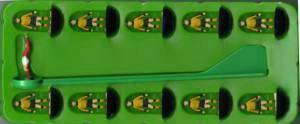
| Peter Upton's |
Subbuteo Tribute Website. |
|
The Early A-Z Range (Set A - Set M); (Set N - Set Z)
This list is again in numerical order. When I was scanning pictures of goals, balls, goalkeepers, etc. I thought it might be easier to put all the similar accessories together, but this did create too many problems and in the end I decided against it. If you think this is an easier way to find what your looking for, then I can again recommend Jon Shelley's site, where he's done just that i.e. a page full of goals, a page of trophies... you get the idea. There are a lot of illustrations on the following pages, so please be patient with them.
August 2000: I now have price lists from 1967 and 1968, which enable me to date these Continental accessories. Items to C112 were available in 1967, C113-C116 became available in 1968, and C117 to C126 were available from 1969.
The Accessories. C100: Complete team of OO Scale dimensional figures.I'm not sure this needs an illustration. If you don't know what a Subbuteo team looks like, then you're showing real dedication to get this far :-)
Oh, go on then just to keep you happy, here's a set:-

The team set obviously went through the most changes of box and player type, and is discussed in detail elsewhere on this website.
In addition to the standard C100, Edilio Parodi's Italian factory produced a range of specially detailed teams which they called C100s. These were enclosed in coloured boxes as shown in the illustration below. See the boxes appendix for details of the various C100 boxes, and all the team colours are now listed in their own pages.
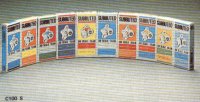
C101: Floodlighting Pylons.
Set 1: Two pylons. Set 2: One pylon.
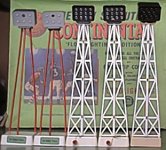

Wouldn't it have been less confusing to have Set one as one pylon, and set two as two? Just a thought... Subbuteo Games eventually figured this out, as the 1970s versions state Set A and Set B.
There were two main versions of these pylons. The early ones were supported by three thin red poles, identical to those in the contemporary red fence (C108), and as the "C" number suggests, these were the first continental accessories produced around 1961. In my set, the straws don't want to fit into the base, and the lights always end up looking wonky. These red lights were replaced in 1971 by the impressive white scaffold version - which in turn lasted all the way to 1989. If you have the 1990 style greek pillar style floodlights, theses were given a new number 61222.
Although I've said that there are two versions of these floodlights, there are variations to each. For those of you who enjoy charting these changes, I'm now pleased to add Jon Shelley's famous floodlight lecture to the site. This lists the floodlight variations by date:-
Red poles, Silver light box with bulb sticking out, Battery box with Subbuteo sticker on front. (Early 60s - 1970ish)
Red Poles, Silver light box Black lens 4-4-4 formation. Battery box with Subbuteo sticker on front. (1970ish)
White Girders Silver light box Black lens 4-4-4 formation. Battery box with no sticker. (1971/2 - 1977/78)
White Girders Silver light box Black lens 4-3-4 formation. Battery box with no sticker. (1977/78 - 1980/81)
White Girders Black light box Black lens 4-3-4 formation. Battery box with contacts and switch. (1980/81 - 1991) Various battery boxes in both white and beige with different sockets and contacts around this period.
The photo of my own floodlights illustrates type one, three and five (with beige battery box and switch). The later 4-3-4 light box has a clip-on front, whereas the 4-4-4 ones are prone to falling out. The later lights also benefit from proper battery contacts and a switch, which were introduced as "new" on the box of the 1978 World Cup set, and were probably a response to changes in safety laws for toys. In 1979 the "A" and "B" versions were dropped and only the two floodlight set remained (this had been the only reference number to have two sets attached to it at that point). However, the one floodlight set then makes a swift return as C171 in 1980-81.
A mains adaptor became available in the early 1980s (C161) which allowed four floodlights to be linked. Floodlights of this period featured an extra socket on top for the adaptor leads.
Mind you, despite all the improvements, the floodlight was still just a very small, weak bulb attached to two wires. This does have one advantage though. If you obtain a 1970s floodlight and attached the ends to the contacts of a battery, chances are you will get a weak glimmer of light. Sadly, this is all anybody ever got from this item. It's completely useless.
When I was a kid, I couldn't afford floodlights, but instead used an Action Man searchlight. This was a similar size and ran off the same chunky flat battery (now sadly unavailable). The Action Man searchlight did have the power of a torch, and if I had owned four of them, I could've had a decent floodlit game. So this should not have been beyond Subbuteo's designers.
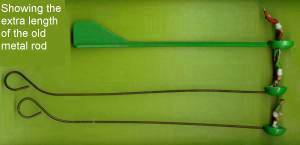
A simple pack of replacement goalkeepers for when you had sat on the originals. They went through various incarnations. The 1960s version was on a metal rod, which was much longer than the rods on the flat goalkeepers and had a more comfortable handle. These could vary in length as the illustration above shows, but all of them were considerably longer than the green rods that came later. This meant that if you played a kid who owned an early set, he could sweep the whole penalty area clear of ball and attacking players whilst "making a save". There was one type of diving goalkeeper in the 1960s, shown (but not very clearly) as the middle goalkeeper above.
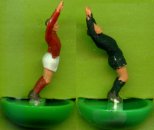

The green plastic rods arrived around 1969-70 and are another sound Subbuteo design that survived the whole OO production period. In the 1970's there were two similar goalkeeper types:- static with hands above head, and diving back with bent knees as shown. There is not a lot of difference between them, and the arm positions are identical. However, while the leaning back one may have looked much nicer, he had slightly less height, and I always found that the curve helped the ball into the net. I know, a bad workman and all that...
The leaning back ones seem more common in early sets, and all the catalogues up to 1979 show both (with more of the leaning back ones). When the team boxes changed to having plastic inserts in the mid-1970s these originally had space for both types of goalkeeper, but later versions of this lift-off lid box only had room for the straight backed goalkeeper. The "single window" box that appeared in 1978 also had no room for the leaning 'keeper. However, by that time, Subbuteo had changed the keeper once more.
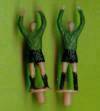
At the end of the 1970's there were a couple of outfield player redesigns as Subbuteo teams switched from hand painted to machine painted. These teams were accompanied by a new goalkeeper type, which then became the standard goalkeeper. The first appearance in a catalogue for this goalkeeper was 1980, but they seem to have arrived earlier than that. Interestingly, this new goalkeeper was not initially machine printed.
This keeper started on a slot base, and did not move to a round peg until the mid 1980s. The first English catalogue to show the peg is 1986 (and the live-action keepers C123 last longer than that on a bar).
The Hasbro keeper is still this basic design, but the most recent version seems to be slightly slimmer with a less detailed casting. This makes him look more fragile than a goalkeeper should be. I've scanned two versions of the peg goalkeeper as a comparison, but they don't look a great deal different in the picture. The older one is on the left.
The set was boxed until the mid 1980s when it was bubble packed. It returned to a box for the 1990s.
Other goalkeeping "C" numbers are C105. C106, C123, C133, C153, C201, C202 and C203.
C103: Tracksuited Team.
Available in red, yellow, dark blue or light blue.



![]()
![]()
This is another accessory that closely followed the introduction of the OO scale teams, arriving in 1962. The 1960s catalogues offered the set in a choice of light blue or dark blue. These were joined in 1970 by red and yellow versions. In the early sets the colours were painted onto white plastic, but in the later 1960s sets, and throughout the 1970s all four kits were moulded in the relevant coloured plastic, so only hair and flesh needed to added by the painters. The 1971-72 catalogue stated that the two blue versions were available "whilst stocks last", but stocks did manage to last right through to the final catalogue appearance in 1977, although it is possible that they changed their mind. If you can make out the style of the tracksuit on the yellow figure above, you can see how out of date they were getting in the 1970s.
When I set up this website, I hadn't seen this set (it was before
my time) so I've been indebted to the e-mails about it, and the pictures sent in
by Joe Butt.
Box Types:- This set was originally produced in a flat square box, with pitch detail interior. This box was not a great idea as it was thin and flimsy, and there was hardly room for the bases in the insert. So the players tend to roll around in the box. Sensibly, they were soon put into a version of the standard team box. This had the advantage of being able to use the same inserts as the team (with the eleventh player taking up the goalkeeper position). The box was updated in the 1970s style, and they lasted just long enough to get a "Chiddingstone Causeway" addressed version of this final box.
C104: Photographers, trainer and manager.
...add big-game realism when placed behind the goals and on the touchline.
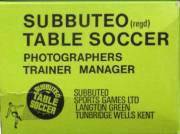
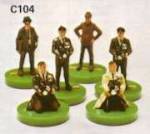

As you can see, two versions were produced. The first set was produced from 1962 until the mid 1970s. These were bar and groove figures, like heavyweight players, and were available on a thick plain base or a thinner base with a logo. The cameramen in this set are holding huge box cameras with impressive flash guns, and the manager looks more like a bank manager, with trilby hat and a suitcase. The trainer wears a cloth cap and a baggy jumper, which was normally painted in light blue. Charles Stadden invoiced for work on this set in September 1962.
This set was still shown in 1975/76, but by 1978 it had been replaced by a set of smaller figures which were matched to the ball boys and VIP set. In the new version the manager wore a sheep skin coat, and the trainer was more of a medic with tracksuit and bag. The cameramen now had small cameras, and in a humourous touch, one of the seated ones looked very bored...
The newer version lasted until 1986 on this number, after which it combined with the ball boys and police to become 61214. That continued until 1996 when it combined sets again to become 61239. It also appeared in C187/2 from 1981 to 1983.
Colour Variations.
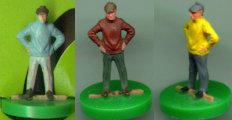
The cameramen in the early set are a selection of drab greys and browns. Luckily, although the trainer was usually in light blue, this is not always the case, as these scans show. The claret wearing trainer does seem to be lurking at the back of the 1975-76 catalogue (shown at the top of this entry).
There is a distinct lack of variation in the later version of this set despite about twenty years of production. Basically, the greys, browns and blacks on trousers, shoes or hats are interchangeable, and the best you can hope for is matching or contrasting grey or brown jackets and trousers on the standing photographers. Yawn.
C105: Two crouching goalkeepers.
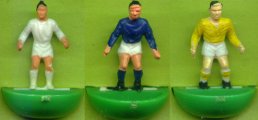
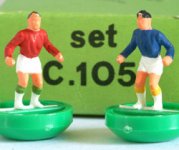
A simple set that arrived in 1963, this gave you the choice of having a tiny goalkeeper with no reach. Not a very useful set then, but the upright pose might bounce the ball back out into play, whereas the leaning back diving goalkeepers seemed to bounce it into the net... These goalkeepers were the norm in box sets of the 1960s and early 1970s, where they sat nicely in the box (the leaning back diving ones don't). They also appeared in 1960s teams, but were not as common there as the diving version. Once we reach the green rod 'keepers of the 1970s, the crouching goalkeepers slowly disappear from the team sets, and the team boxes with plastic inserts that arrived in 1977 made no allowance for them.
They were absent from the 1978 catalogue where their place in the range was taken by the much more practical diving goalkeepers with caps (C153). Their place in the set of interchangeable goalies (C133) was also taken by the capped goalies at this time. However, my original box set from 1979 did feature a pair (one in all white, one in a green jersey). Perhaps this was how SSG finished up the stock.
The picture above shows three different versions of the crouching goalkeeper. The one in white is the original 1960s casting. The two in the full editions wear green and white and all white (like this one). They really are tiny, especially on the small 1960s base. In the 1970s the crouching goalkeeper was enlarged, and this figure is shown here in a blue jumper. The third 'keeper illustrated is a strange one. I only own one of these, and he came from an interchangeable goalkeeper set. He's chunky, has a real action pose, and frankly looks more like a rugby player than Subbuteo's rugby player.


Box types:- As with C102, the metal rod keepers were usually sold bagged, but a box does exist. The plastic handled goalkeepers were sold in the usual goalkeeper boxes of the early 1970s, the only difference between the sets being the reference numbers on the end flaps. Again, these boxes had card inserts to protect the 'keepers.
Thanks to Ashley Hemming for the photo of the metal keepers.
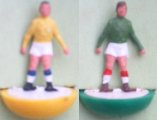

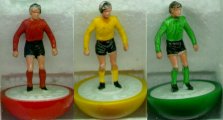
Two goalkeepers without rods, or in reality, two normal outfield figures painted in colours which hopefully made them look like goalkeepers (i.e. black shorts!). This set was useful for goal kicks, and manic "Bruce Grobblelaar" style rushes out the box. Normally, I just used whatever spare outfield players I had hanging around, so the set was not crucial. The set was down graded to "request only" on the 1983 price list, and did not appear on the 1985 poster. Later cash-ins on the same theme are C202 and C203 from the early 1980s.
The pictures now illustrate various spare goalkeepers through the ages. The original heavyweights shown left, are painted to match the 'keepers on rods from that era, with sock hoops that contrast with their shirts. This paint design carried onto the classic heavyweight (shown middle) and a common early version of this set was green shirt with red sock trim, and red shirt with green sock trim. In the 1970s, goalkeepers in sets were usually painted with socks that matched their shirts. The spare goalkeepers changed to match this, although these were usually painted with black shorts, which was more uncommon on rodded versions. More h/w spare goalkeepers can be seen on the heavyweight team list.
For the lightweight era (shown right) the spare goalkeepers kept to this formula, and as black shorts had also become the norm for the rodded keepers, these matched up nicely. On the above picture, the red goalkeeper is hand-painted whereas the other two are machine printed. The green shirted goalkeeper is in a 1990s base (small letters) suggesting that the set was still sold beyond its final catalogue date. Blue shirts in machine-print or hand-paint were also produced.
C107: Referee and two linesmen.
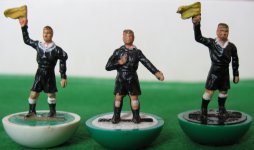

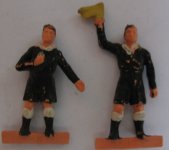
One of the more obvious accessories for any football game, the referee and linemen set was a straight lift from the 1950s celluloid range. Charles Stadden's invoice for his work on the set is dated June 1963, and they first appeared in the 1963-64 catalogue (introduced August 1963). As usual with Subbuteo there were variations to the set, which I'll deal with below.
The Heavyweight Version 1963-78.
Charles Stadden's original set had a chunky design, which sat in the standard (slotted) heavyweight player bases. It was an old school look, with baggy clothing and long shorts. The refereee was well detailed, with his hand holding the whistle, and a clear top pocket.
The long life of this figure (and usual Subbuteo eccentricity), has created a multitude of variations. The figures were usually produced in black plastic, so a minimum of painting was required. However, referees on flesh and white plastic also exist in reasonable numbers. The base colours also varied of course. The most common is probably a green outer/white inner, but the reverse also turns up, and looks quite nice. A black inner on green outer is also reasonably common.
However, the most bizarre variation (catalogued in the early 1970s) was the "maroon" version. This was produced in claret plastic, and base inners of the same colour were usually used (although white inners were also used). There is some sense to having different based referees. If you were a Plymouth fan, your referee would clash bases with your team... although did anyone actually play with these figures on the pitch?
Pack type:- A small accessory, so simply sold in a bag, with headed card.
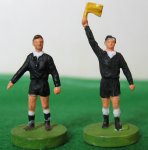
The Accessory Based version 1980-84
The heavyweight accessory figures were looking out-dated by the late 1970s, and the decision was made to update them. The new referees first appeared in the 1980 catalogue, and were scaled to match the other new "stand around the pitch" figures such as the ball boys, and new police/photographer sets. As such, the new figures were placed on the small accessory bases. This meant the linesmen looked good against the other figures on the touchline, but the referee was dwarfed by the players. I assume this experiment was not a huge success though, as the officials soon found their way back onto player bases.
Pack type:- The small-based referees have been seen in all three bubble pack styles from the period.
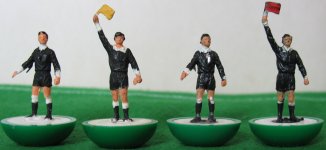
The Lightweight based version 1985-96.
By 1985 the thin officials had been put back onto (pegged) player bases. This was especially pleasing for those of us that liked to field a refs team as a "minnow" in cup competitions alongside the spare goalkeeper team (the linesmen just fall over, but the ref can play a bit). This version lasted through to 1995, and then combined with the flag set (61188) to become the new 61240. They also featured in the Premiership boxed edition and accessory set (61234) wearing dark green shirts. The pegged officials were originally produced in white plastic, but later sets returned to the black plastic of the 1960s. The flags should be one yellow and one red, but are sometimes painted in flesh colour instead!
Pack type:- They would have been sold in the final "goal net" style of bubble pack, before being sold in one of the small "pitch corner" accessory boxes in the 1990s.
A completely new design of referee was produced for the 1998 and 2001 Premiership Editions.
C108: Plastic Fence Surround.
...including advertisements which
achieve a realistic appearance.

Designed to keep the ball on the table, the fence has gone through two major incarnations under this number. First up was the red fence, with big advertising hoardings supporting a single line of straw-like poles at a height that stops a standard football
. This red set was introduced in 1963, and was a marked improvement on the "clips and string" of Set Y. The poles were those used in the red floodlights set.The second
version was a picket fence design, made of green plastic with brown supports. Usually four of the fence panels had room for advertisements on them (do I even need to tell you this - who hasn't seen one??). The green version was "new for July 1970" in the 1970-71 catalogue, where it featured alongside the red fence (the old fence was dropped the following year). From then on, it was available right through to the final accessory range of 1996-97, and featured in the 2003 editions. Lucky then, that it was a sound design, and worked really well.Green fences are so common, that most collectors have enough sets to put the advertising boards right around the ground. As you normally got 4 advertising boards, and 20 plain fence panels, you need six sets to replace all the plain fence. Well unless you bought the Euro 96 box set where half the fence (i.e. 12 pieces) was advertising hoardings, but frankly that's cheating. If you are feeling especially eager, you can try to go around the ground without repeating any adverts. This is certainly possible, probably even without the Euro 96 set (does anyone else have a Olau Cross Channel Car Ferry board??) Certainly, with such a long length of service, you could probably fill this page with the different advertising alternatives, but that goes beyond even my remit :-). Well, it does for now. If I'm bored in a few months, who knows....
The later fence was also produced with brown panels for the rugby game, white panels and blue posts for the cricket game, and in the 1990s it appeared in red with white posts for the Manchester United Edition. So it should be possible for an Italian collector to use the green, white and red panels to go around the ground (although cricket fences can be tricky to locate these days).
The fence was looking out of date in the 1980's, and for a time it had a rival in the crowd barrier (C170) . However, that didn't prove popular, and left the lists even before the real-life crowd barriers were taken down.
C109 Two fully assembled
deluxe goals.
manufactured in strong white plastic available with BLACK or WHITE
P.V.C. plastic netting.
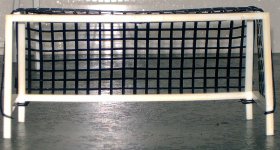
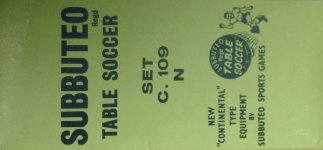
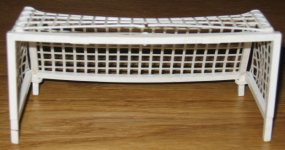
For years, this poor item has had to put up with a simple catalogue description and a poor joke about the other uses of PVC.... but finally, we have pictures and details.
This goal was a short lived item at the very start of the Continental era (1963-64 to 1965-66 only). As the "N" on the box suggests, this was simply the standard plastic Subbuteo goal, but with a hard plastic net. The net had four small plastic loops which simply hooked onto the front and back posts of the goal. This did leave the goal open at the back struts to possibly let the ball through, although the plastic is quite firm.
It actually made for quite an attractive set, but I'm not sure what advantages there were over the standard nets (perhaps just one of cost). Maybe by leaving the old nets in the flat range (as set N), Peter Adolph was hoping the buyers of continental equipment would automatically order these goals when they needed new ones, but the short life suggests that Subbuteo buyers were unconvinced. I've also been advised that these goals have been sighted in Display Editions dated to 1965.
September 2008: A big thank you to Ashley Hemming who supplied the pictures and details on this item, and to Martyn Burr who sent in the picture of the white plastic version.
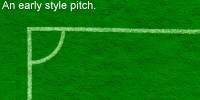

The Subbuteo pitch was previously sold in the earlier A-Z range, but having two ranges was confusing, so it made sense to switch it. This finally occurred in 1973, but for a few years it retained its old number as well, so it was C109M. Again, the standard pitch had all sorts of variants in its long life. The early pitches did not have the Subbuteo written on them, and had chunky lines and big penalty spots. In the 1970s they had a variety of different sized logos. In cost cutting measures, the pitches got thinner in the late 1970s so that the white lines were visible from the reverse side. Then from 1981 the material changed to a thin nylon, with visible threads running across it. These nylon pitches had a tendency to crease, and the edges were likely to start unraveling. In addition the surface could fluff up, to the point where the player's arm got caught during swerves.
Other pitches in the range include the Astropitch, (C178), and the Italia '90 pitch (61221). In the late 1990s there were Premiership and Man Utd pitches in the box sets, as well as a Hasbro "cotton" pitch from 1997. This was reminiscent of the classic 1970s pitches (but with the new logos, and not quite as thick material).
Pack types:- I believe that the pitch was not boxed until the monochrome logo era (1981-83). Before that, the pitches seem to be have been sold in clear bags.
C110: TV Tower.
Complete with TV camera and monitor, cameraman and
commentator.
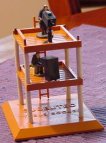
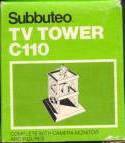
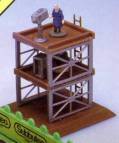
Another popular
item of Subbuteo, this was produced very early in the range (1964), and was available right through to the Hasbro era. In design it was a square brown tower which was supplied ready assembled. You received four figures with the tower. On the top was a cameraman in a thick blue coat, complete with camera. On the middle floor was the commentator complete with monitor (to watch the replays). The camera and monitor had spikes that fixed them to the platforms. The monitor had two spikes, whilst the camera had just one, and you could not assemble the tower in any other way. However, the cameraman and commentator were free to slide around and fall over. Charles Stadden invoiced for the people (but not the tower) in June 1964.The first illustration above shows the early 1960s version of this item. On this original TV Tower the vertical supports were simply copper poles wrapped in white plastic (matching the goals and goal-holders of that era). The plastic parts of this tower were also a lighter shade of brown. The much more common plastic sided version arrived in the late 1960s.
The set passed
through about five box types and lasted on C110/61110 until
1985 when it merged with the 1980's cameramen
to make set 61208. Between 1981 and 1983 it had a
rival, the grey TV Tower kit (C186). As with the fence surround, the classic accessory proved the more appealing item.
C111: Half-Time Scoreboard.
Another accessory to add realism to your stadium layout... contains "score cards".
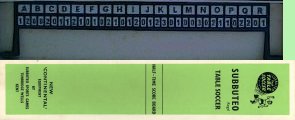


At some point in the late 1960s the scoreboard was changed to a version that clipped into the red fence surround. This version reduced the number of scores displayed (from 18 to 7), but supplied scorecards that could be cut out and slid into the board making it useable. The catalogues did not make it clear when the changeover occurred, but the best bet is the 1969-70 catalogue where the price increased to 3/6d. However, scorecards were not mentioned until the following year (the 1970-71 catalogue rewrote a lot of item descriptions). Of course, 1970-71 was also the year that the green fence debuted, so it is possible that the red half-time scoreboard had a very short life.
With the arrival of the green fence came the final version of this board. This worked in exactly the same way as the red board by slotting into the fence and by having scorecards. The brown posts from the fence surround were often glued onto the ends of this item (but not always).


Box types:- The original black scoreboard came in a lovely long thin 1960s box with white sides and stapled ends.
The red scoreboard received an illustrated box matched to the other early 1970s accessories, such as the flags and the training packs.
The green scoreboard was sold in the same box as the red fence for most of its life, although it did get a box with a more accurate illustration in the hobby-crest re-box. The final 1980 date means that any later boxes are unlikely.
C112: Football Club Flag.
Mounted on pole and stand, the flag is available in red, white, blue, maroon, and old gold. Cut out adhesive sheets supplied showing individual teams of the English and Scottish leagues and a wide range of international teams.
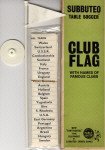
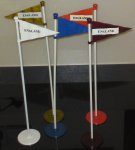
Although the flag left the accessory range in 1972, it continued to feature in the big boxed editions of the mid 1970s, such as the Munich World Series and International Editions.
C113(a):
Football Club Flag
Mounted on pole and stand, the flag is available in red, white, blue, maroon, and old gold.
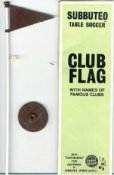
C113: Ambulance and Policeman Set.
Comprising 2 stretcher bearers, stretcher patient, and two policemen.

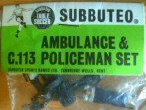
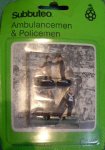
Pack types: Both sets would have been sold in bags, with a standard Subbuteo stapled header card (mid-1970s version shown). The later set appeared on the first (hobby-crest) bubble card.
The original price of this set was 4s 2d
C114(a): Team
Sheets.
For use with the Football Club Flag.
As mentioned above, this original use of C114 appears in the 1965-66 catalogue. The adhesive sheets cost 1s 9d.
C114: Mascot and bench set.
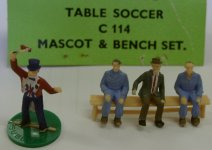
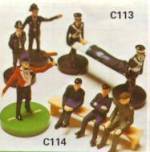
The mascot in the top hat is Ken Baily, who also appeared on the Football Express box. Somewhat unsurprisingly, there are variations to this set
as well. The original set (shown left) was introduced in 1967-68, had a manager in a tie, and reserves in old style tracksuits. Ken Baily has his rattle in his right hand. The set was illustrated in 1972-73. The newer set was illustrated with the new C113 in 1975-76. Here, there is one sub with his arms crossed, and one with his legs crossed. The manager has a cloth cap, and somehow reminds me of Bill Shankly. Here Mr Baily is waving his rattle in his left hand. I expect both versions of Ken are available in the two base variations - thin and named, or thick and plain.The bench set was replaced in 1976/77 by C139 which was the first outing for the more familiar clear plastic bench. That originally featured the same bench occupants as the final C114 (sadly minus Ken).
C115: Subbuteo Tie.
C115(Z): Match Score Recorder.
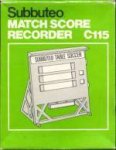
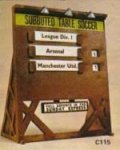
This was a sensible re-number of the lovely brown match scoreboard that had been introduced as a replacement Set Z in 1969. As the replacement flags of this vintage came straight into the Continental range, it does seem odd that this set did not get a new number on arrival. It became C115 in 1973, and continued on that number until 1978. The catalogues used the "Z" suffix until 1977, probably because the set was still being sold in the original box. This old number was finally dropped with the "hobby crest" box produced in the late 1970s.
The scoresheets supplied just covered the English and Scottish leagues, and the home nations, although World Cup team names were also issued and foreign boards included their own sheets. The British team names were updated when necessary with Hereford replacing Barrow, and Wimbledon appearing in the final sets.
The last issue of the board was a World Cup 1978 version with World Cup name cards printed in red. It was replaced in 1979 by the black stadium scoreboard (C158), which had large legs designed to display the board over the new terracing.
A rugby version of the board was also produced with slot in score cards as opposed to rotating wheels. This outlasted the football board in the UK, surviving until the end of the rugby game in 1983-84
The football version was still being advertised in Dutch catalogues of the early 1980s.
Box types:- Just the two boxes. The early 1970s "waving boy", shown under Set Z, and the "hobby crest" version shown here.
C116: Car Sticker.
3in. diameter... in red, green and black on white vinyl, depicting a Subbuteo footballer motif. Suitable for sticking on cars, and bicycle saddlebags.
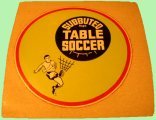
C116(C): Subbuteo Handbook.
A fully illustrated booklet of elementary and advanced rules for the experienced player, explaining the best methods of beating your opponent.
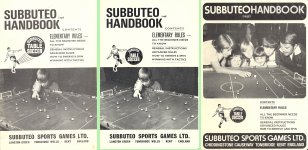
This was previously available as item "C" in the old A-Z range. By the mid 1970s the basic rules, advanced rules, and the "spin!" booklet were all combined into one handbook, and that became the new C116. Of course, this was also the rule book in the boxed sets, so you only needed to buy C116 if your dog (or gerbil) ate the original.
This combined handbook had different rules in the basic and advanced sections, and was pretty confusing to new starters (I should know, as I was one). So the basic rules were soon split out again. The full handbook survived until 1981-82. Its replacement in 1983 was a "revised" handbook on ref C193. Like the original C116, this only had the more advanced tournament rules within it.
The version illustrated above is the 1970-71 edition, when the booklet was still just the advanced rules. This differed from the earlier ones in that Peter Adolph's name had been removed, and the Players Association was no longer plugged. Instead, there was a personal message from G C Samson, the managing director of Subbuteo Sports Games.
C117: Six Pitch Flags.
Four corner flags on bases with built-in ball raising recesses for improved corner kicks, and two halfway line flags.
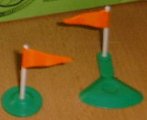
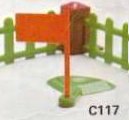
There are two versions. The original set (shown left) had a triangular orange flag on a white stick. A drawing of these appeared as "new" in the late 1960s catalogue. These had quite a short period of production, as by the time of the first illustrated price list (1972-73) these had been replaced by the much more common big square flags (shown right). The square flags were closer in look to the old Set T.
Both types of flag came on the same green bases. Whilst Set T was designed to push through the cloth (and therefore hide the bases), the plastic base sat on top of the pitch. Subbuteo's designers made this into a positive change by providing a ball-raising recess on the corner flags, to make lofted corners much easier. The flag itself was then on a thin bar, so as not to interfere with the player taking the corner. I have been advised that this worked really well, as long as you were willing to stick the base down (blu-tac would do). When not taking corners, the flag could be turned around, so that the base did not encroach onto the field.
As I've already mentioned, the flags soon found their way into the boxed editions of Subbuteo from the Club Edition upwards. Room was made for them below the pitch in the early 1970s sets. As most kids had to play Subbuteo on the floor, and as the flags were near the edges of the pitch, most quickly broke, and it is hard to find sets with a full set of flags within them.
The big flags reign came to an end when a


Box Types:- The flags were originally sold in a long thin box, complete with card insert to keep them safe. This was an illustrated early 1970s box with kicking logo, and a nice demonstration of how they worked. This was the only box the triangular flags were sold in, although the square flags also used it. This shape of box was updated to the "hobby crest" range (not illustrated yet), before being replaced by a smaller square box, where the flags were jumbled in loose (the rugby flags received a similar box at the same time). It is unusual for any accessory to have two boxes within the same range, but this one does seem to.
C118: European Competition Trophy.
C119: Jules Rimet World Cup.


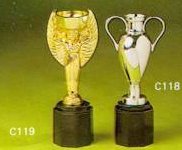

These two cups arrived in 1969, and were the first in an intermittent series of replica trophies. Obviously not in any Subbuteo scale, these sets are basically designed to look nice on a shelf in your games room (you don't have a games room?) The original boxes folded so you could display the cups within them, and had nice coloured inserts to make the cups stand out.
The Subbuteo book Flick to Kick mentions a full size World Cup sculpted for Subbuteo by Dave Pomeroy, which was to be scaled by their head draughtsman, Keith Buckwell. The tale goes that when the World Cup was stolen, Mr Buckwell put their full sized copy in the window of the Subbuteo offices with a "for sale" sign, which resulted in a police raid. The real cup was stolen in March 1966, so this story suggests that Subbuteo were aiming to release their version for the 1966 campaign. However, it was actually released later than that. We turn once again to Charles Stadden's invoices for further insight into the design process.
08/03/67: Replica of the World Cup carved in tin alloy. Size of figure and cup 3 3/8". Steel spigot set under base to fit in plinth. £45.10s Plinth carved in wood octagonal, 8 sides, recessed top. Eight plates, one to each of the sides. £8.10s European Cup, carved and engraved, separate plinth. £35
The European Cup (C120) is another item that needs a little explanation. The one produced by Subbuteo was the smaller version held aloft by Real Madrid countless times in the late 1950s. However, by 1967 (and Celtic's win) the cup had already changed to the design still handed out today to the Champions League winner. Mind you, even the Observer's Book of Football of the 1970s still showed this old trophy, so perhaps we can forgive the error. I wonder how many of us bought it in the 1970s/1980s thinking it was the European Championship trophy.
The later style of European Cup finally arrived as C204 in 1983.
Both these cups survived right through the "Continental" number era, with the European Competitions Cup bowing out in 1983, just missing a 61xxx number. However the Jules Rimet did hang on until 1984 to briefly become 61119. This may seem surprising as the Jules Rimet was, of course, won outright by Brazil in 1970 and all subsequent World Cups have used a different trophy. I guess the Jules Rimet's survival was down to its attractiveness, plus the fact that England won it in 1966, That match must've been replayed in miniature ever afterwards. Either that, or the stock sold very slowly.... Interestingly, the new style World Cup only turned up in time for the 1982 championships (C182) - and even then it didn't succeed in out lasting the Jules Rimet - both were removed in 1984.
Actually, Subbuteo have a run of bad luck on their cups. This started with the original European Cup not being the version won by Celtic or Manchester United. Then the Jules Rimet was won outright one year after Subbuteo produced it. Then the League Cup was produced just before the Milk Cup replaced it, and the corrected European Cup was produced just as English sides were being chucked out of Europe. Sad, but true.
Also strange. The Jules Rimet is obviously referred to as "the World Cup" in the early catalogues, until 1974 when it needs to be differentiated from the new version. In the 1974 catalogue, there is a star next to this item, and at the bottom of the list it says "* - Jules Rimet version - limited stocks only". Obviously not that limited.....
Box types: The original "diving goalkeeper" box used for these cups, and the statuette (C120), are the most common version. The cups were both transferred to the late 1970s illustrated box (hobby crest era).
C120: Footballer Statuette.
On a plinth in all club colours.



This set was introduced alongside the two cups in the 1969 catalogue. Charles Stadden invoiced for a 3" statuette of footballer about to kick the ball. Carved and engraved in whitemetal (tin alloy)" two weeks before his invoice for the World Cup shown above, so this lovely figure must be his work.
The statuette came in the same design of box as the cups, with a similar insert. The nice original catalogue illustration (shown middle, above), suggested that the Cup plinth would be used, but but in fact the player received a short round plinth instead (as shown in the photo). This obviously helped with stability.
The statue could be hand-painted in any of the club colours on the team lists. As it survived in the catalogues until 1975-76, (being removed in the 1977 purge), this suggests that it could be painted in any team colours up to reference 190. However, the unsold stock of this item floating around the Subbuteo collecting community suggests that the more common range would be that of 1971-72, which was 1-81 plus the 1970 World Cup sides (later added to the team range between 150 and 166). The 1971-72 catalogue does stress that new teams 76-81 are available under C120, and a separate 1970 World Cup flyer advised that "teams and statues" were available in the named box range.
However, a few later reference numbers have been sighted, the most common being ref 93 Roma. I have also seen the "named box" Derby County in statue form (shown on the Team odds and ends page).
I would suggest that if the early numbers were only selling slowly, the later ones would have been painted by request only. I could be wrong though. I originally suspected that shops would only keep a few popular teams in this format, but Chris McKay remembers his local stockist in Edinburgh having all the major Scottish teams in 1971. So anything is possible.
Box types:- Just the one box for this accessory - as illustrated. Never mind, as there are lots of statues to collect instead.
This seems a good point to take a break, the page having already grown rather long. If you wish to push on deep into the heart of the 1970's, then you can follow the links laid out below.
The Early A-Z Range (Set A - Set M); (Set N - Set Z)
The Continental Range (C100-C120); (C121-C139); (C140-C169); (C170-C191).
The Waddingtons/Hasbro Additions (C201-61221), (61222-61240 + reused numbers).
[ Main Page | Previous Page | Next Page ]